|
Changes in Shuttle Bus Route and Schedule
Will Improve Service SNS Milestone Set at Berkeley Lab Changes in Shuttle Bus Route and Schedule
|
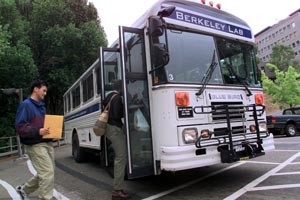 |
Berkeley Lab’s offsite shuttle bus routes and schedules will undergo some changes next month, and Laboratory riders should find the services both more timely and more efficient.
Beginning on March 4, the primary route to downtown will be along Hearst Avenue, resulting in quicker access to the downtown BART station, north campus, and Building 937. Every 10 minutes from 6:30 a.m. to 5:40 p.m. the shuttle will follow Hearst west down the hill to Oxford Avenue, then continue south on Oxford to Center Street, and right on Center to the BART terminal on Shattuck. From 5:50 to 6:50 p.m., buses will leave every 20 minutes.
Buses will continue to run along the more circuitous route across Gayley Road and down Bancroft Avenue every 30 minutes, leaving from Building 65 on the hour and half-hour from 6:30 a.m. to 4 p.m. The two routes together will provide an additional two buses per hour traveling to the BART station. The return routes remain the same for both routes: west on Center, north on Milvia, and east up the hill on Hearst.
Changes to 937, Rockridge shuttle service
As part of the schedule adjustments, the separate twice-per-hour shuttle van to Building 937 in downtown Berkeley will be eliminated. However, the Hearst buses, which run six times per hour, will include a new stop at the corner of Oxford and University avenue, a block away from the 937 entrance.
“This will allow our buses to be more dependable,” said Tammy Brown, supervisor of bus services at the Lab. “With all of the changes that have been made over the years to the Bancroft route — such as stop signs, lights, new construction, and increased auto and pedestrian traffic — we found it very difficult to meet our commitments to passengers, especially at peak times of the day.”
Although the route for the Rockridge bus will not change, the schedule has been adjusted to make for less frequent but more reliable trips to the BART station there. Lab buses will leave Rockridge at 6:40, 7:40 and 8:40 a.m., with return trips from the Building 65 bus station at 3:40, 4:40, 5:40 and 6:40 p.m.
To add convenience to the Rockridge route, passengers will be able to board the outbound buses from several locations: the Building 65 hub, the cafeteria bus stop, the Fire House, and Strawberry Gate.
The onsite bus route and every-10-minute schedule will not change.
* * *
According to figures compiled last October by Bus Services, the offsite buses accounted for 56 percent of all passengers during the month and the onsite shuttle for 29 percent. The Strawberry route — which will not change under the new schedules — accounted for 10 percent of the riders, with the Rockridge bus at 3 percent and the Building 937 shuttle at 2 percent.
Brown said that although bus service staffing will not be affected by the changes, she expects the cost per passenger to be reduced. The 937 shuttle van, which required one and a half full-time drivers, averaged just under 40 passengers a day. Under the new program, the same drivers will take full-size buses on additional trips on the main routes.
The daily bus passenger count has been about 1,300 per day.
“Bus operators have told us that it is extremely difficult to try to maintain the posted schedule, drive safely, check everyone’s identification, and provide a comfortable and courteous bus service,”Brown said. “We hope these changes will offer our operators a greater measure of control while still giving riders the service they expect. It may mean that some may have to walk a little bit farther to their destination, or plan a bit further ahead when going to the Bancroft and Telegraph area,” she added. “But it also means our buses will be on time more often, and our employees won’t have to face unexpected delays due to backed-up schedules.”
Most notorious of the impediments have been the interruptions along Bancroft Avenue. Each day, drivers face an obstacle course of double-parked cars, pedestrians in crosswalks at and between intersections, stop signs, and traffic lights. At commute hours, the trip on Gayley Road across campus and along Piedmont Avenue heading toward Rockridge approaches gridlock. Under the new plan, the last Bancroft-bound bus of the day will leave the Lab at 4 p.m., before the heaviest traffic hits campus.
The new routes will be posted on the bus services web site (http://www.lbl.gov/Workplace/Facilities/SiteSvcs/indexbus.htm) beginning Feb. 15, and will be described on posters on buses, at bus stops, and throughout the Lab. The next issue of Currents (Feb. 22) will include new route maps and schedules. And the bus signage on poles along the Bancroft route to BART will list anticipated arrival times for each of the 20 daily trips.
By Paul Preuss
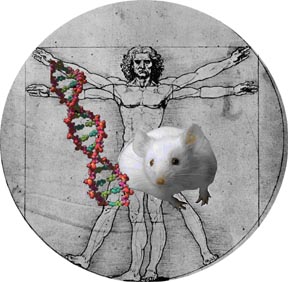 |
Inna Dubchak of the National Energy Research Scientific Computing Center (NERSC) has specialized in computer programs that make biological databases more useful. When her colleagues in the Genome Science Department asked her to develop a database of noncoding regions in the genomes of human, mouse, and other organisms, she realized there were no good tools for comparing one genome with another in a simple, easy-to-read way. “So I set out to make one.”
What Dubchak and her collaborators came up with was a computational tool that could compare a lot more than just noncoding DNA. VISTA — Visualization Tools for Alignments — can compare sequences of virtually any length, from a single gene or less up to entire genomes.
Entering the Genomic Era
A year ago, well ahead of schedule, the Human Genome Project reached its goal of sequencing the entire human genome. Unlike the Atomic Era, however, the sudden onset of the Genomic Era has been less than earthshaking.
“When a decision on sequencing the whole human genome was made in 1993, biologists thought they would learn the answers to all their questions,” Dubchak says. “Then they looked more closely and realized that having one genome doesn’t really give you much.” Instead, progress is more likely to come from comparing the genomes of different organisms.
These days the emphasis is not just on counting genes but seeing what makes them tick. “The post-genomic era is devoted to discovering regulatory mechanisms,” Dubchak says — finding the means by which genes turn on and off, singly or in interaction with other genes. “Supposedly all major regulatory elements live in the noncoding regions of DNA.”
Often regulatory sequences are only a few base-pairs long, much harder to find and easier to confuse than long, patterned gene sequences. One way to discover them in noncoding DNA (few call it “junk” anymore) is by searching conserved areas, sequences that have persisted for millions or hundreds of millions of years of evolution.
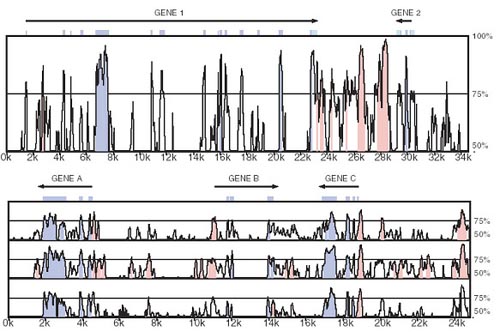 (top) Two-organism comparison (human-mouse). (bottom) Three-organism comparison (human-mouse-rabbit). |
Genome comparison is crucial to the process. If a given DNA sequence is substantially similar in both mouse and human, for example, that sequence has persisted since the common ancestor of mice and humans, some 80 to 100 million years. It is not surprising to find the same sequence conserved in monkeys, pigs, and rabbits; there may even be some comparison to more distant species like chickens or fugu fish. (See Currents, Dec. 21 2001.)
VISTA can compare sequences from two organisms or several, looking for similarities, or compare the DNA of closely related species, underlining their differences. The program can look for regulatory sequences as well as genes; it can analyze noncoding sequences for stretches that are actively conserved. All of these tools are available on the web, where biologists can use the VISTA server or download a stand-alone package.
Making it easy on the user
The user begins by entering a finished sequence of any length from one organism, then adds sequences from the other organisms to be compared; these may even be in draft form. An alignment engine called AVID automatically brings sequences of the various organisms side by side.
Next a sliding “window,” its length (in base pairs) specified by the user, moves along the sequence of the first organism, counting the number of identical nucleotides in the comparison organism within the window centered at each base position and calculating the degree of identity between them.
VISTA plots the nucleotide sequence of the first organism from right to left and vertically plots the percent identity of the organism to which it is being compared. The result is a visual series of little mountain peaks, sequences of specified length and a minimum degree of identity, their similarities obvious at a glance. If the sequence of the first organism has been annotated — noting where genes begin and end and where other known features reside — what these features have in common with the comparison organism becomes visible at a glance.
When comparing two closely related species like human and chimpanzee, biologists are more interested in differences than in similarities. Not long ago, chimpanzees were considered so genetically similar to humans that it was hard to understand how our physical differences had arisen. VISTA graphically points up the differences among genes and other DNA sequences common to humans and nonhuman primates, giving hints of their evolutionary origins.
VISTA has also been used extensively to compare the conserved regions in the whole genomes of the human and mouse, finding regions at any level of conservation the user defines. Every human chromosome contains regions with a high degree of mouse-human similarity.
Although noncoding regions in two species could be similar by accident, similarity in three or more species means they have been conserved in evolution. By comparing sequences from at least three organisms — human, mouse, and dog, for example — conserved noncoding sequences are quickly identified.
Tracking down potential regulatory sequences within noncoding regions
uses a “flavor” of VISTA that draws upon other existing databases to hone
in on likely gene-regulation sites. In them, any short regions (20 base
pairs) with greater than 80 percent identity are swiftly identified.
A panoramic VISTA
“In the beginning, we realized that the possible comparisons between DNA sequences from different organisms are potentially endless,” Dubchak says. “We had to find a way to focus in. We began by designing tools that could compare two sequences of limited length; now we are comparing entire genomes.”
 |
By sifting valuable “ore” out of the increasing amounts of sequences that are emerging from genome-sequencing institutions around the world, VISTA is one of the tools that’s helping the Genomic Era deliver on its promises. Since the VISTA server went online in mid-2000, nearly 6,000 queries have been handled, coming from over 600 users in 26 countries. Three hundred and twenty copies of the stand-alone program have been distributed.
To build VISTA, Dubchak worked with both biologists and computer scientists: biologist Edward Rubin, with Poulabi Bannerjee, Dario Boffelli, Kelly Frazer, Gabriela Loots, and Len Pennacchio; mathematician Lior Pachter; and computer scientists and programmers Alexander Poliakov, Jody Schwartz, Chris Mayor, Michael Brudno, Ivan Ovcharenko, and Nicolas Bray.
For more about VISTA, visit http://www-gsd.lbl.gov/vista/.
By Lynn Yarris
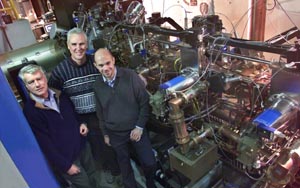 Leaders of the SNS Front-End team include (from the left) Rod Keller, John Staples and Alex Ratti. They are shown here next to the recently completed RFQ |
With a deadline less than four months away, Berkeley Lab scientists and engineers cleared a major hurdle for completing their part of the Spallation Neutron Source (SNS) — the accelerator-based facility that will provide the most intense pulsed-beams of neutrons ever available for scientific research and industrial development. On Friday, Jan. 25, at around 4:30 p.m., they drew their first ion beam out of the radio-frequency quadrupole (RFQ) accelerator that is the third and perhaps most technically challenging of the four components in the SNS “front-end” system.
“The 2.5 million electron volts (MeV) beam came out at a current of 24 milliamps (mA) on the very first try!” said Rick Gough, the physicist who heads the Ion Beam Technology (IBT) program for the Accelerator and Fusion Research Division (AFRD). “ A full characterization of the beam with peak-currents up to 33 mA is now underway. This current is already sufficient to support operation of the SNS at 1.2 MW average power.”
Said Rod Keller, the physicist who serves as senior team leader of the SNS Front-End Group, “To save costs, we had to make a production model and test it without the advantage of first working with a prototype. This is risky business with an RFQ accelerator because you never know what you have until you test it. Either your accelerator works or it doesn’t, and in this case it worked extraordinarily well!”
The design of the SNS RFQ was led by AFRD physicist John Staples, who also led the design of the four previous RFQs built here at Berkeley Lab.
“At nearly four meters in length, this is the longest RFQ we’ve ever built, which presents a big challenge in terms of field stability and tuning” says Staples. “This RFQ also had to handle the most powerful beam at a higher current and operate at a duty factor (the fraction of system operational time in which a beam is actually produced) about 60 times greater than any we’ve built before.”
Says Gough, “That all of these challenges were so successfully met is a credit to the team effort that has characterized the work of the Front-End Group throughout this project.”
In the building (71) that once housed the SuperHILAC, the 40 scientists, engineers and technicians who comprise the SNS Front-End Group have now completed and successfully tested three-fourths of their assignment. Last spring, the group commissioned the negative hydrogen ion source and low-energy beam transport (LEBT) system.
The fourth and final component of the SNS front-end system, the medium-energy beam transport (MEBT) system, has already been built and will be attached to the RFQ for testing later this spring. When testing is complete, the front-end system’s components will again be separated for shipment to Oak Ridge National Laboratory (ORNL), which will be the host institute for the SNS.
Each of the partner labs collaborating on the SNS was delegated a specific responsibility. Berkeley Lab’s responsibility, the front-end system, is required to create a beam of negative hydrogen ions and prepare it for delivery into the SNS linac. Negative hydrogen ions are accelerated in the front-end system and the linac because they lend themselves to efficient injection into the accumulator ring. As they are injected into the accumulator ring, the hydrogen ions are stripped of their electrons and converted into positively-charged hydrogen ions, or protons.
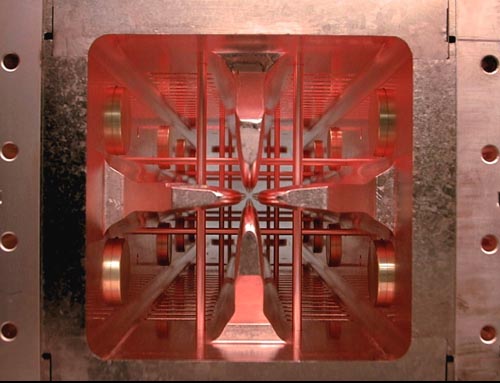 Inside the cavity of the SNS RFQ are four, water-cooled copper vanes configured so that the application of radio-frequency electrical fields will bunch and simultaneously accelerate and focus a beam of negative hydrogen ions passing through them. |
The first two components of the front-end system, the ion source and the LEBT, combine to create a low-energy, continuous beam of negative hydrogen ions. It is the role of the RFQ to prepare these negative ions for injection into the SNS linac by breaking the beam into discrete bunches at radiowave-sized pulse lengths, then accelerating those pulses to 2.5 MeV energy while simultaneously keeping them focused in a narrow beam.
The SNS RFQ consists of an encased cavity containing four strategically modulated copper electrodes or vanes between which radio-frequency electric fields are applied. These fields act on the beam both longitudinally and transversely to first establish the bunch structure, and then (due to increased depth of the vane modulations) accelerate the bunched beam to the full energy of 2.5 MeV.
Because of the quadrupole arrangement of the vanes, these fields also overcome the effects of space-charge forces that would otherwise cause the beam’s negatively-charged ions to fly apart.
Careful temperature control of the RFQ structure is required to keep things properly working as the radiofrequency power used to manipulate the ions also heats up the inner surfaces of the RFQ cavity. Usually, thermal expansion effects are compensated by moveable mechanical “tuners,” but Steve Virostek of Engineering Division (ED), the lead mechanical engineer for the RFQ system, working with ED designer, Matt Hoff, came up with a unique water-cooling scheme that is far more cost effective and also boosts the system’s reliability.
“The design decisions to achieve dimensional stability of the RFQ during startup conditions and normal operating conditions were based mainly on Steve’s analyses of the transient heat loads and heat distribution,” says ED’s Dick DiGennaro, chief engineer for the front-end system.
A series of tiny water channels run through the RFQ’s cavity wall and copper vanes. The water temperature in the wall is held at a constant 24 degrees Celsius, while the water temperature running through the vanes is varied as needed.
Explains Virostek, “This cooling scheme, along with 80 pre-machined, fixed slug tuners, has proven to be a reliable and effective solution to tuning the SNS RFQ. The cost savings as compared to a moveable tuner system is as much as $200,000, which is a significant fraction of the total RFQ fabrication cost.”
The beam generated during the RFQ testing was directed into various devices for diagnostic purposes. Beam testing and characterization will soon be completed and the RFQ will be shut down for about six weeks so that the installation of the remaining MEBT parts can resume. The role of the MEBT is to create short gaps in the beam by chopping it into minipulses of 645 nanoseconds duration with separations of 300 nanoseconds in order to facilitate the beam’s ultimate extraction from the SNS accumulator ring.
“The completion and successful testing of the SNS RFQ has been a huge milestone for us and a terrific accomplishment for Berkeley’s Front End team,” says Gough. “As we approach the final countdown, I’m pleased to say that we’re still within budget and on schedule to begin shipping to ORNL in June.”
In addition to those already mentioned, other key members of the SNS Front-End Group include project manager Ron Yourd and lead electrical systems engineer Alex Ratti.
The Spallation Neutron Source project is a collaboration between Berkeley Lab, Oak Ridge National Laboratory (ORNL), which will house the SNS, and the Argonne, Brookhaven, Jefferson, and Los Alamos national laboratories.
When the SNS goes online (scheduled for the year 2006), it will be capable of delivering an average of 1.4 million watts of neutron beam power onto a target, more than 10 times the capacity of today's most powerful pulsed neutron sources. The scattering of these neutrons when they strike experimental samples will reveal to scientists and engineers the most intimate structural details of a wide range of materials.
The SNS generates its neutron beams through the combination of a linear accelerator (linac) and accumulator ring which result in the production of a one-microsecond long pulsed beam of protons, energized to about one billion electron volts. This yields a pulsed beam of hot neutrons that is immediately cooled to room or even lower temperatures and directed into samples for nondestructive neutron scattering studies.
James Decker, acting director of DOE’s Office of Science, in a speech before the DOE/National Science Foundation’s High Energy Physics Advisory Panel (HEPAP), said that the Bush administration plans to hold science programs to tough standards and that federal R&D programs are going to have to prove their worth.
“There’s a great focus in this administration on the management of government programs — in how well they’re managed,” Decker said. “It will be important in deciding whether they’ll invest their resources in an initiative. The administration is very interested in whether programs are delivering on what they’ve promised.”
Decker said the administration wants to develop criteria for funding federal research programs and is focusing its attention on DOE programs. He pointed out that DOE and OMB are developing performance standards for DOE basic science initiatives, and that criteria could be ready by spring for the administration to use in preparing the agency’s FY2004 budget.
DOE is preparing a study on how well the Office of Science manages its national laboratories in comparison to lab management by other agencies. A report is expected in March.
Members of the DOE/NSF High Energy Physics Advisory Panel (HEPAP) unanimously endorsed a proposal to construct a new high-energy high-luminosity electron-positron linear collider (LC), saying it should be the cornerstone of the U.S. research agenda in high-energy physics for the next two decades. The LC would accelerate electrons and positrons to energies reaching the tevatron regime and collide them in beams a thousand times narrower than a human hair. HEPAP tabbed the LC as its highest priority, whether it is built in the United States, in Europe or in Japan, although our nation “stands to gain considerable scientific and economic benefits if the facility were hosted onshore,” the report said.
The cost would be high, estimated to run from $5 billion to $7 billion. A HEPAP subpanel projected the United States would pick up about two-thirds of the tab. About $1 billion to $2 billion of the U.S. cost “could be supported through sacrifice and redirection of the present U.S. high-energy program, taking advantage of resources available in our laboratories and universities,” according to the report.
Building the LC in the U.S. and continuing R&D at other domestic accelerators would require boosting total funding for U.S. high-energy physics about 30 percent over the next two decades.
“The case for the machine is as strong as its mission is clear,” said HEPAP member Jonathan Bagger of Johns Hopkins University. “This promises to be one of the greatest science adventures of our time.”
The report, which also lays out a 20-year roadmap for high-energy physics
research in the U.S., can be viewed online at http://bohr.pha.jhu.edu/~bagger/report.pdf.
— Lynn Yarris
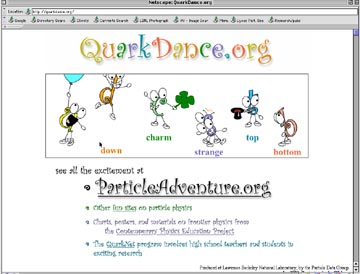 |
Strange quarks are the least of it in a new animation at QuarkDance.org — a gaggle of frivolous fermions whose names students will find easy to learn and impossible to forget. Lincoln Sanders, who did the animation, and Laura Ochoa-Frongia, who helped him find the truly obnoxious music, are in the Physics Division's Particle Data Group. The new page adds further spice to the already hot ParticleAdventure.org, one of the web's most honored educational sites.
On Monday, Secretary of Energy Spencer Abraham released the Department of Energy’s Fiscal Year 2003 budget request to Congress, calling for $21.9 billion for programs in the areas of national security, energy, environment, and science and technology.
In keeping with President Bush’s call in the State of the Union address to “do what is necessary to ensure our nation’s security,” the DOE requested $8 billion for the National Nuclear Security Administration (NNSA), his top budgetary priority.
The Secretary said that “future research, development and production plans are geared to the Administration’s defense strategy,” and discussed DOE efforts to devote resources to implement the administration’s National Energy Plan, direct research and development toward new ideas and innovation, and move technologies from the laboratory to the marketplace.
The $8 billion NNSA budget represents an increase of $433 million (5.7 percent) over FY 2002. Included is funding for Defense Nuclear Nonproliferation ($1.1 billion) and Directed Stockpile Work and Campaigns ($3.3 billion).
A quick look at the Administration’s budget request indicates that Berkeley Lab would be looking at a FY 2003 budget at, or slightly above, the FY02 level. More specific information about the budget’s impact on the Laboratory will be published in the next issue of Currents.
n The Office of Science, which funds the national laboratories, would receive $3.3 billion for FY 2003 under the new budget request, a slight increase over the FY 2002 level. This budget would support increased funding for operations and instrumentation at Office of Science user facilities, including universities, industry and government research.
This request also provides continued funding for the construction of the Spallation Neutron Source and increases for research in areas such as nanoscience, climate change, the Human Genome and Genomes to Life programs, and Scientific Discovery through Advanced Computing. Also included would be funds to counter the infrastructure deterioration at the national laboratories.
n Energy: The request is for $2.4 billion for FY2003. This includes $277.1 million for the Weatherization Assistance Program; $150 million for the FreedomCAR program, which refocuses transportation R&D toward fuel cell powered vehicles and developing the infrastructure to make hydrogen an available fuel source; funding to implement the $2 billion, 10-year Clean Coal Technology initiative and increase research into carbon sequestration; and $38.5 million to launch “Nuclear Power 2010,” a cooperative initiative with industry to develop advanced nuclear technologies leading to the startup of new nuclear plants by 2010.
The budget also supports the collaboration of nine leading nuclear nations to develop Generation IV nuclear energy systems, the next generation of reactor and fuel cycle technologies.
n Environment: The budget calls for $7.4 billion, a $169 million increase above FY 2002. As a result of the DOE’s top-to-bottom Environmental Management Program review unveiled last week, Secretary Abraham requested $6.7 billion to support the program’s goals. Included are provisions for basic funding at every site and $800 million for sites that agree to participate in “fast-track cleanup.”
The Office of Civilian Radioactive Waste Management would receive $150 million for the geologic disposal program. The budget also includes $130 million for the Office of Environment, Safety and Health and $26 million for the Office of Worker and Community Transition.
The entire FY 2003 budget can be accessed online at http://www.mbe.doe.gov/budget/03budget/index.htm. — Monica Friedlander
By Monica Friedlander
Early last summer, Charlotte Bochra of the Lab’s Health Services Department was taking inventory in the storeroom in Building 26 when she realized that a large excess of medical supplies could no longer be used at the Lab due to changes in federal regulations affecting devices used for injections and blood drawing. Bochra could have simply disposed of the boxfuls of non-compliant needles and syringes. Instead, she thought of the people all over the world who could put them to good, even life-saving, use.
“These supplies are sterile,” she said. “Third world and other countries don’t have so many regulations and are happy to take our old equipment.”
So Bochra went web surfing in search of an appropriate charitable organization to which the Lab could donate these supplies. She and Dr. Peter Lichty, group leader for Health Services, decided on Direct Relief International, a California-based nonprofit organization that has been providing medical aid and emergency relief to locally-run health programs in poor countries around the world since 1948. All items supplied by Direct Relief are practical, safe, and recognizable to the people who use them.
“This organization is highly regarded in the field of donating medical supplies,” Bochra said. “I knew the supplies would go to someone who could and would use them.”
Health Services contacted Direct Relief — one of the top rated charity organizations in the country — which was more than happy to put the more than $2,600’s worth of supplies to good use.
“It was extremely thoughtful of the Laboratory to make this donation, and right on the mark with regards to the needs of the facilities in developing countries that we support,” said Cathleen Grabowski, a pharmacist with Direct Relief. “We want to support medical practitioners and empower them with things they need to improve their medical practices. Syringes and needles are perfect examples. Without them people are tempted to break proper safety technique.”
The medical supplies donated by the Lab cannot be used in the United States since the Needlestick Safety and Prevention Act went into effect in April of 2001. The new law revised the federal bloodborne pathogens standard, which requires specific safety standards to be implemented in the workplace to reduce the risk of needlestick injuries. Needles that retract into the syringe and sliding, or hinged, shields attached to phlebotomy needles are examples of the new improved engineering controls.
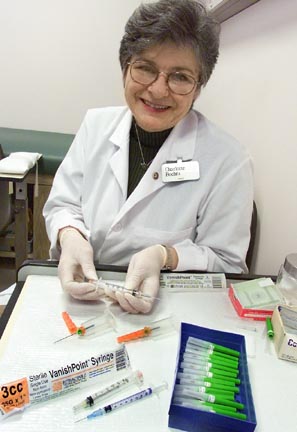  Charlotte Bochra of Health Services demonstrates the new needles and syringes that have replaced those the Lab donated to Direct Relief International. The organization works to improve access to health care to the poor in nations around the world, such as the children from India pictured above. |
By being a good Samaritan and donating these supplies, the Lab ended up actually saving money. The only cost involved in the donation was the shipping charge, while the cost of disposing of syringes and needles as medical waste would have been considerably higher.
In order to carry out the donation, the Lab needed to first get approval from the Department of Energy, a process that took several months to complete. Gavin Robillard of the Facilities Department took care of the paperwork. In December Health Services received the go-ahead from DOE-Oakland, and went on to package three large boxes of medical supplies that were immediately shipped to Direct Relief.
Last year alone, Direct Relief International has provided $81 million in assistance to more than 10 million people in 60 countries. Their aim is to improve the health and lives of people living in developing countries who are victimized by poverty, disaster or war.
Right now, for instance, Grabowski is working on a large shipment of pharmaceuticals and medical supplies to be sent to poor rural hospitals in Bulgaria. The country is undergoing economical restructuring, and the shortages are so acute that medical care in rural hospitals is mostly limited to surgery and trauma patients. Even serious medical conditions, such as hypertension and diabetes, are often left untreated, Grabowski said. It is in such areas that Direct Relief, often in partnership with other organizations, can make the biggest difference.
And in their own way, Charlotte Bochra and the Lab’s Health Services Department know that they have also made a real contribution to this humanitarian effort — and done so in the most efficient way possible.
“Environmentally speaking,” Bochra said, “we are recycling these items without destroying product. And we know they’re going to a good cause.”
By Dan Krotz
 |
To better understand how contaminants such as pesticides travel across the continent, researchers from Berkeley Lab and Canada’s Trent University have incorporated into a single model toxic release data, wind and water current patterns, and regional differences such as soil and vegetation.
The BETR model, which derives its name from the two institutions involved, improves on traditional atmospheric models by more completely reflecting how persistent organic pollutants move and accumulate throughout North America. Chiefly, contaminants such as dioxin, DDT, and mercury don’t simply drift with prevailing winds. They’re also absorbed by the soil, water and vegetation because of a natural tendency to maintain equilibrium with the environment. Whenever a persistent pollutant drifts into a region, a percentage of it penetrates into the landscape until its air, soil, vegetation, and water concentrations are in balance. If a new air mass containing the same pollutant moves in, the equilibrium is unbalanced and some of the absorbed compound is released until a new homeostasis is attained.
“This is how contaminants leapfrog across the continent, and why air transport models don’t really work for many persistent organic pollutants,” says Tom McKone of the Environmental Energy Technologies Division.
In addition, because persistent pollutants are continuously absorbed and reabsorbed as they drift with prevailing winds, conventional air tests can easily underestimate the amount of contaminant in an area. At any given time, most of the pollutant may be in the soil, not in the air.
To account for contaminants’ complex jitterbug across the continent, McKone’s research group and his Trent University colleagues divided North America into 24 regions largely based on watershed and soil type. In the Midwest, for example, the Missouri and Cheyenne Rivers watershed region is neighbored to the south by the Arkansas River-High Plains region. Each region is further subdivided into seven compartments: upper atmosphere, lower atmosphere, vegetation, soil, fresh water, coastal water, and freshwater sediment.
The characteristics of these compartments enable the model to determine how each region absorbs a specific contaminant. For example, soil absorbs chemicals based on its organic carbon content, water content, and porosity, so a loamy soil absorbs chemicals differently than a clay soil. Likewise, saltwater absorbs chemicals differently than fresh water. And with vegetation, the more lipid contained in the leaves of a region’s plants, the more a fat-soluble chemical is absorbed.
Much like a chemical equation, the model pits the absorption traits of each region’s compartments (air, soil, etc.) against the solubility of a specific contaminant. So, if airborne dioxin drifts into the Great Lakes Basin region, the model runs seven mass balance equations — one for each equilibrium relationship between dioxin and the region’s seven compartments — until the relative amount of dioxin in the air and environment is calculated.
To give the model a continental scale, a database of hydrological and meteorological information determines how wind, rivers, and coastal water ferry contaminants from region to region. By overlaying this transport data onto 168 mass balance equations (seven for each of the 24 regions), the model maps the pathway and eventual fate of a contaminant as it is transported across North America.
So far, the model has been tested using real-world data associated with toxaphene, a banned pesticide that was once widely used on cotton crops in the Southeast and is now found in high concentrations in the Great Lakes. The team introduced a hypothetical 10,000 kilogram-per-year release in the lower atmosphere compartment of the Mississippi Delta region, and the model determined that although the compound spread throughout much of North America, the highest concentrations accumulated in the Great Lakes.
“The model reproduces what we see in the real world,” McKone says.
The next step is to use the model to map human exposure, McKone says. Although the BETR model tracks exposure based on inhalation, drinking water, and skin contact, it can’t account for the incredibly complex dynamics that affect food-based exposure.
A person can buy an apple in Chicago that was grown in Washington State but contaminated by pesticides from Mexico. To reflect this complexity, the mass balance of pollutants has to be coupled with the mass balance of food. In other words, determine where a region’s fish, meat, milk, produce, and grains are imported from, and backtrack to the source regions to determine how much contaminant each food absorbed.
McKone believes such a food-pollutant web will enable EPA officials to not only determine whether there’s too much pesticide in Chicago’s produce, but where the produce came from, and most importantly, where the pesticide originated — the root cause of the problem.
“The BETR model of contaminant fate is very important, but it’s an exercise in environmental chemistry,” McKone says. “We can add human exposure data to the model and help to better inform regulatory policy.”
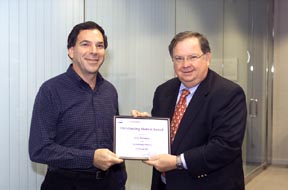 |
Rick Norman (left), pictured here with Lab Director Charles Shank, was named an “Outstanding Mentor for 2001” by the Lab’s Center for Science and Engineering Education. He was chosen based on comments from the students with whom he worked as well as on his long history of commitment to education outreach.
"Mentoring is an important part of what we do here," said Shank, who has mentored many students himself. "It’s important for us as scientists to shape the future by nurturing new scientists."
The City of Berkeley is offering a series of lectures about energy efficiency, renewable energy and other environmental issues. All lectures are free and open to the public, and are held from 7 to 8:30 p.m. in Room 7 of the Berkeley Adult School (University Avenue at Bonar Street).
Berkeley Lab’s Energy and Environmental Technologies Division and the UC Berkeley Energy and Resources Group are working with the City’s Energy Office to provide technical advice on energy issues as part of the Berkeley Energy Technical Advisory Group (BETAG).
Upcoming lectures
To reserve space at the lectures, send an e-mail to energy@ci.berkeley.ca.us or call 981-5435.
For a full schedule of lectures and other information, visit the City’s Energy Office website at http://www.ci.berkeley.ca.us/Energy/Lectures.html.
Tax Relief Act 2001: Make it Work for You
Fidelity Investments will return to Berkeley Lab on Wednesday, Feb. 13 to present a workshop on strategies to help you make the most out of the changes implemented as a result of the Tax Relief Reconciliation Act of 2001. Topics will include retirement savings, lowering income taxes, and saving for your children’s education. The session will be held from 12:30 to 1:30 p.m. in Perseverance Hall (cafeteria building).
In addition to this workshop, Fidelity Investments representatives will be available for individual consultations with Lab employees on Feb. 13 and March 13 from 9 a.m. to 5 p.m. These consultations are offered by appointment only, and will be held in Building 65A.
To make a reservation for the workshop or to schedule a personal consultation, call Fidelity at 1-800-642-7131.
EH&S Training has added another EHS 10 class (Introduction to EH&S at Berkeley Lab) to this month’s schedule. The session will be held on Thursday, Feb. 28 from 1:30 to 3 p.m. in the Building 50 auditorium.
Please note that the New Employee Orientation will not be held in conjunction with this session of EHS 10.
Everyone is invited to attend.
DEPARTMENT OF PHYSICS COLLOQUIUM
Femtosecond Laser Probing of Molecular Wave Packets and
Time-Resolved Soft X-Ray Photoelectron Spectroscopy
Speaker: Stephen R. Leone, JILA Fellow
4:30 p.m., 1 Le Conte Hall
LIFE SCIENCES DIVISION SEMINAR
Molecular Profiling of Breast Cancer
Speaker: Saraswati Sukumar,
Johns Hopkins University School of Medicine
4:00 p.m., Bldg. 66 auditorium
PHYSICS DIVISION RESEARCH PROGRESS MEETING
The Universe from the Dark Ages to the Present: Quazar Science
from the Sloan Digital Sky Survey
Speaker: Dan Vanden Berk, Fermi National Accelerator Laboratory
4:00 p.m., Bldg. 50A, Room 5132
LIFE SCIENCES DIVISION SEMINAR
Genetics of Hypercholesterolemia and Atherosclerosis:
Lessons from Mendelian Disorders of Lipid Metabolism
Speaker: Helen Hobbs, University of Texas Southwestern Medical Center
Noon, Bldg. 66 auditorium
BERKELEY SPECTROSCOPY CLUB SEMINAR
NMR Spectroscopy: A Bright Subject with a Dim Bulb
Speaker: Jeffrey Reimer, Environmental Energy Technologies Division
10:00 a.m., Bldg. 6, Room 2202
SPECIAL PHYSICS DIVISION RESEARCH PROGRESS MEETING
An Insider's View of International Terrorism
Speaker: Jay Davis, Center for Global Security Research, LLNL
Noon, Bldg. 50 auditorium
GLENN T. SEABORG CENTER SEMINAR
Structural Characterization of Actinide – Metal Interactions in
Non-crystalline Molecular Systems
Speaker: Christophe Den Auwer, CEA Marcoule DEN/DRCP/SCPS
5:00 p.m., Bldg. 70A, Room 3377
PHYSICS DIVISION RESEARCH PROGRESS MEETING
Particle Physics and the Role of Fundamental Constants
Speaker: Harald Fritzsch, University of Munich, Germany
4:00 p.m., Bldg. 50A, Room 5132
CENTER FOR BEAM PHYSICS SEMINAR SERIES
Why the Symplectic Group Is Good for Classical Mechanics:
A Pedagogical and Evangelical Talk
Speaker: Alex Dragt, University of Maryland & LBNL
10:30 a.m., Bldg 71, Room 264 (Albert Ghiorso Conference Room)
LIFE SCIENCES DIVISION SEMINAR
DNA-PK and p53: Caretakers and Gatekeepers of Genomes
Speaker: Carl W. Anderson, Brookhaven National Laboratory
4:00 p.m., Bldg 66 auditorium
LIFE SCIENCES DIVISION INFORMAL SEMINAR
Spectrin Pathways: Mechanisms for Membrane Stabilization and Protein
Accumulation
Speaker: Anthony J. Baines, University of Kent, United Kingdom
Noon, Bldg 84, Room 318
PHYSICS DIVISION RESEARCH PROGRESS MEETING
Synchrotron Storage Rings for Neutral Molecules and Atoms
Speaker: Harvey Gould, Chemical Sciences
4 p.m., Bldg. 50A-5132
CENTER FOR BEAM PHYSICS SEMINAR SERIES
Ion Acceleration with Ultra-High Intensity Lasers
Speaker: Manuel Hegelich, Ludwig-Maximilian-Universtaet Muenchen
10:30 a.m., Bldg 71, Room 264 (Albert Ghiorso Conference Room)
Refreshments served at 10:20 a.m.
Send us your announcements
Announcements for the General Calendar and Bulletin Board page may be sent to MSFriedlander@lbl.gov. Seminar & Lectures items may be mailed to currents_calendar@ lbl.gov. You may also fax items to X6641 or mail them to Bldg. 65B. The deadline for the Feb. 22 issue is 5 p.m. Monday, Feb. 18.
NEW EMPLOYEE ORIENTATION
Starts at 8:00 a.m., Bldg. 50 auditorium
FEBRUARY 14, Thursday
SHOEMOBILE
7:30 a.m. -– 3:30 p.m., cafeteria parking lot
PRESIDENTS’ DAY HOLIDAY
SHOEMOBILE
7:30 a.m. – 3:30 p.m., cafeteria parking lot
‘00 BMW 328Ci, 2 dr, perfect, 34K mi, blue/grey leather, at, premium pkg, pwr everything, am/fm/cd + 6 disc cd changer, xenon headlights, cruise, front & side airbags, traction control, moonrf, rear spoiler, $36K/bo, Curtis, X5417, (925) 680-7465
‘99 TOYOTA CAMRY LE, 4 dr, dk grn, 20 K mi, auto, V6 3.0L, pwr win/locks, dual pwr seat/air bag, am/ fm/cass/cd, sliding sunrf, exc cond, single owner, $17,000b/o, Ilham, X7001, 368-4765
‘98 HONDA ACCORD, 50K mi, silver/beige, 4 dr, service rec'd, at, ac, cd, all pwr, $12,000/bo, X4010, 845-4264
‘95 VW JETTA GL, 29K mi, blk, 5 spd, 4 dr, ac, sunrf, pwr steer/locks, dual airbags, alarm, am/fm/cass, premium sound, $9,750/ bo, Steve, X6966, 204-9494
‘94 JEEP WRANGLER 2.5L, hard top, blk, 76K mi, many extras/new parts, 1 owner, $7,700/bo, Max, X6524, (925) 937-9471
‘94 Honda Accord LX, at, ac, 78 K mi, very good cond, $7,100, Ike, X1849.
‘94 FORD ESCORT GT, hatch, 96K mi, white, at, ac, cruise, am/fm/cass, rear spoiler, pwr side mirrors, reg to 1/03, very good cond, $3,650 (well below Blue Book retail), Ron, X4410, 276-8079
‘92 MITSUBISHI ECLIPSE GS 16v dohc coupe 2dr, red, at, 11K+ mi, alarm, remote pwr lock/steer, ac, tilt wheel, am/fm/cass, good running cond, $2600, Liu, X5625, 234-2317
’92 MERCURY SABLE, 4 dr, tan/brwn, new tires, 93K mi, great cond, $1,600/bo, Hal, 841-092
‘90 PONTIAC GRAND AM LE Coupe, 2 dr, 113K mi, bright red, tan int, 4-cycl 2.3l quad-4, at, ac, cruise, pwr steer, alloy wheels, am/fm/cass, new belts/ignition system, clean in/out, needs work, $950/bo, Sven, X4053, 548-4484
‘86 CHEVY NOVA, 160K mi, red, 4 dr hatch, 5 spd, exc cond, new alt, catl, conv, batt, good for commuting, $750/bo, KC, X4010, 845-4264
‘78 VOLVO 4 dr sedan, new tires, radio, well maint, rec’s avail, good commute car, $750/bo, John, X5307, 841-7875
‘78 MUSTANG II, 6 cyl, 2.8L, at, under 55K mi, white ext/blue int, very well maint, service rec’s, rear seat folds for extra storage, reg fees/smog cert good to 1/03, Kathy, X4931
ALBANY, sunny 1 bdrm apt, 2nd flr, just off Solano, nr shops/pub trans, secur syst, lge closets, dw, table & chairs, garage, laundry, intercom, small pet ok, avail 3/1, $1,230/ mo, Felicia, X6597, 654-3693
BERKELEY HILLS house, 2 bdrm/1-1/2 bth, 1553 La Vereda nr La Loma, furn, near Lab, $2,400/mo w/ year lease, price & length of lease neg, Sandelco Properties, 652-8200
BERKELEY, furn rooms in 6 bdrm/2 bth ‘House of Scholars’, 1425 Ward @ Sacramento, house phone, w/d, common liv rm & kitchen, house computer w/ DSL access, offstr parking, housecleaning, 2 mo min stay, $670-790/mo + 15% util, Anushka, 486-8153, housintscholar@ mindspring.com
EL SOBRANTE, 1 room avail in 3 bdrm house, must like pets (owner has Border Collie mix), common kitchen, bth & liv rm, w/d, $500/mo + 1/3 util, Karen, X4012, KSEdwards @lbl.gov
GLENVIEW/OAKLAND craftsman home, 2 bdrm/1 bth, sunny, quiet, formal din rm, hardwd flrs, wood trim throughout house, riverstone fireplace, safe neighborhd, new fixtures in kitchen/bth, 1 car garage w/ storage space, patio/ yard, lemon trees, utilitly bldg (w/d hookup), yard care incl, close to shops & trans, $2,600/mo+1 mo sec dep, avail now, no smoking/dogs, cats neg, refs & credit report req, 459-3006, 3983 Linwood Ave @ Hampel, 459-3006
GLENVIEW/OAKLAND, 1bdrm/1 bth sunny/quiet 2-story cottage/apt attached to back of home, kitchenette, fridge avail if needed, new paint, partial view of hills, 750-800 sq ft, good for 1 person, close to shops/pub trans, $1,100/ mo + 1 mo sec dep, avail now, no smoking/dogs, cats neg, refs & credit report req, 459-3006, 3983 Linwood Ave, 459-3006
VISITING NERSC researchers & family from Switzerland seek 4 bdrm house in Berkeley or nearby, will be at NERSC for at least 1 yr, no pets/smoking, andreas.adelmann@psi.ch, Kymba, X8671
VISITING SCIENTIST seeks 2 bdrm house/apt to rent, non-smoking couple, no children or pets, mid Mar-mid Sept, j.a.wright@ lboro.ac.uk, Phil, X6512
BABY CRIB from Simmons w/ Winnie the Pooh 5 pc bedding set, matching mattress & wetting protector, $200; baby reversible stoller, Aprica, $100, Alex, X2290, (925) 314-0841
FREEZER, 16.1 cu ft upright, white, Wards, $115; Fisher stereo & speakers, digital tuning, dual cass, $45; Patton compact heater, $12, Ron, X4410, 276-8079
FUTON, blk metallic frame w/ 6" mattress, $130; TV table, blk, $20; table & 2 padded chairs, $90; all items in exc cond, used for only a few months, Shirin, X5550, 965-0644 eves
GATEWAY 17" comp monitor, in box never opened, model EV-700, $220, John, X6022, (925) 682-8393
INVERSION TABLE, Body Trends F5000III, exc cond, $125, Gary, X4441
PORTABLE HEATERS, $10/ ea; upright quartz heater, $20; sewing machine, $40; desk w/ 4 drwrs, $40; sofa, loveseat, corner unit, very clean, $350; twin bed set, $100; 2 queen size bed frames, $10/ ea; headboard w/ storage, $30; microwave stand w/ wheel, $20; storage cabinets, $20/ea; solid oak china cabinet, exc cond, $500; fish tank, $15; water ski board, $40; yard tools, more Ming, X5616, 530-0462
SIMMONS MAXIPEDIC twin long mattress, exc cond, dorm size, used 1 semester, matching boxsprng incl, $220, in Albany, Philip, X7307, 558-8856
KIHEI, MAUI, 1 bdrm condo across the street from Kam 2 beach (best beach in Maui), fully equipped, view of ocean/Haleakela, $400+12% Hawaii hotel tax ($450/wk), Fred/Shar 981-2073 days, 523-4150 eves
PARIS, FRANCE, near Eiffel Tower, furn elegant sunny 2 bdrm/1bth apt, avail for sabatical and/or vacation, all year round by wk/mo, Geoffrey, 848-1830
SCOTLAND HOUSE SWAP, from Jul-Aug ’02 (dates neg) w/ residents of Bay Area, teacher from Kirkcaldy lives 30 min from Edinburgh/30 min from St. Andrews, walk to shops, seafront, conv bus & rail connections to all of Scotland & England, house built in 1890, 2+ bdrm/1 bth, kitchen/din, lounge, util rm, garden, no smoking, Jim, X6277, 236-3837
TAHOE KEYS at S. Lake Tahoe, 3 bdrm house, 2-1/2 bth, fenced yard, quiet, sunny, close to attractions, great view of water & mtns, $175/night, 2 night min, Bob, (925)376-2211
EXT CD-ROM DRIVE, 4x, SCSI (Mac), Andre, X6745
Ads are accepted only from LBNL employees, retirees, and onsite DOE personnel. Only items of your own personal property may be offered for sale.
Submissions must include name, affiliation, extension, and home phone. Ads must be submitted in writing to fleamarket@lbl.gov, faxed to X6641, or mailed to Bldg. 65B.
Ads run one issue only unless resubmitted, and are repeated only as space permits. They may not be retracted once submitted for publication.
The deadline for the Feb. 22, 2002 issue is Thursday, Feb. 14.